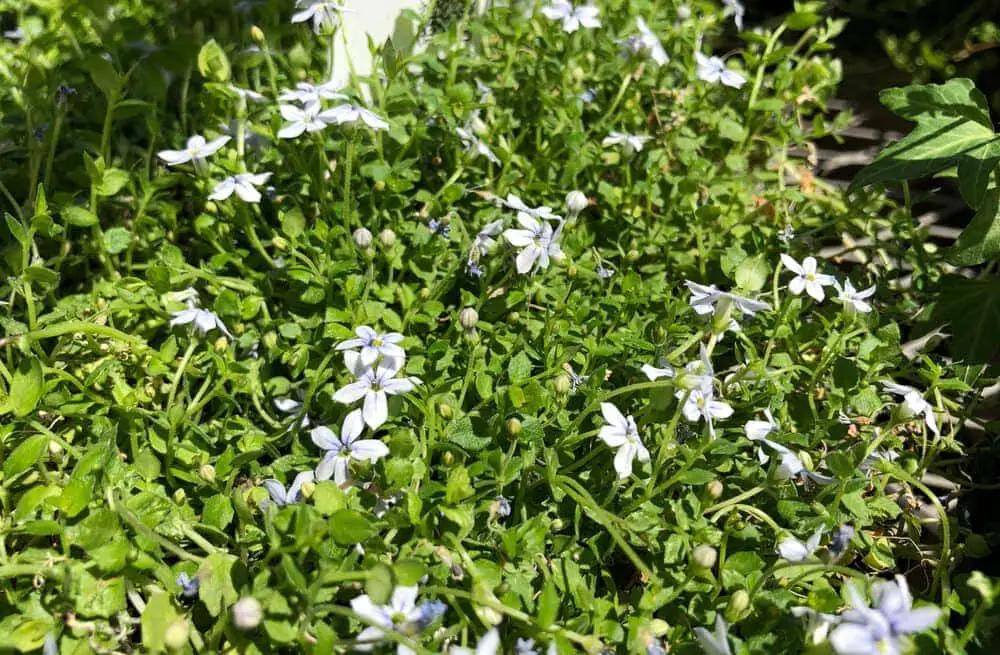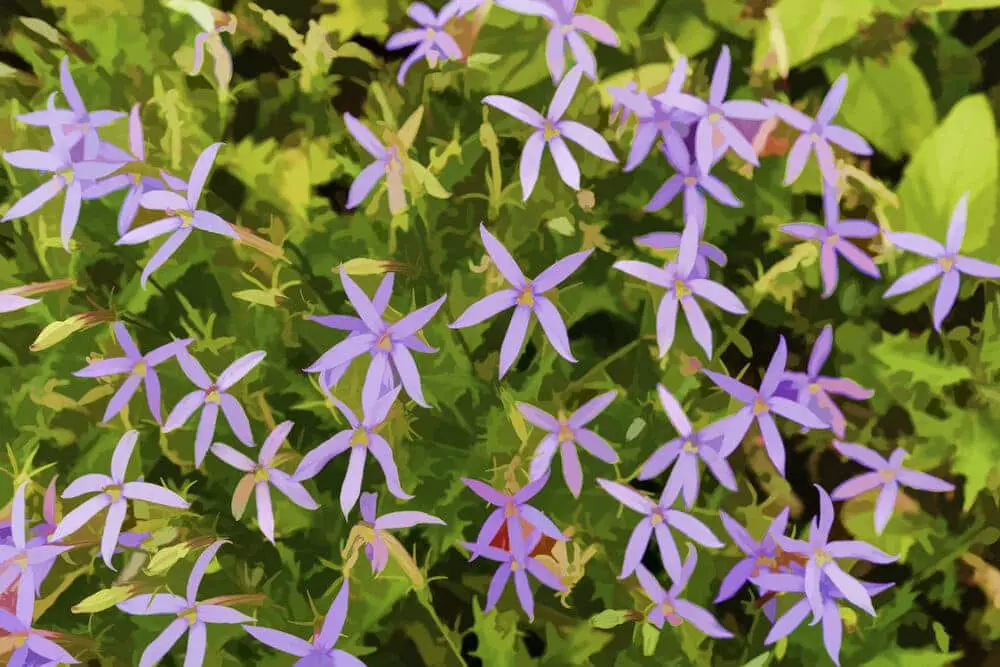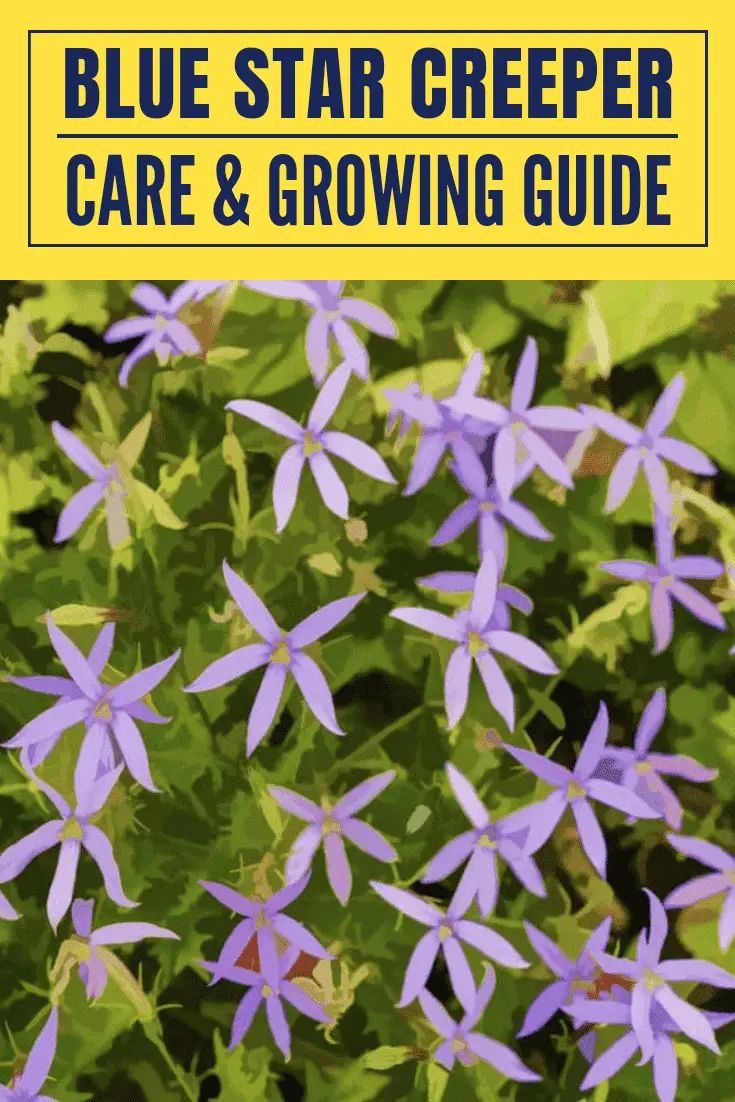Because of its colorful flowers and short height, many people use this plant as a substitute for grass.
Its beautiful blue flowers are a welcome change to the standard grass we all know. It’s a simple plant that is hardy and hard to kill. The flowers have no fragrance, so it won’t provoke your allergies.
Blue Star Creeper Care & Growing guide
1. Light requirements
The blue star creeper thrives best in full direct sunlight. But it is used as a grass alternative so it can handle full sun, bright indirect light, and low indirect light. The less it is exposed to light, the fewer flowers it will have, but it can live off low light.
2. Water
This is a hardy plant that can stand weeks without being watered in the spring, fall, or winter. But in the summer, you will need to water it once a week. If you overwater it, that can cause overgrowth, which steals nutrition from the soil.
3. Climate and temperature
Because of its robustness, this plant can survive in cold weather up to hardiness zone five, even though it would prefer to grow in warm weather. The creeper does best in zone 9 or 10. But the heat cannot be so intense that the ground also turns warm. The plant itself can stand temperature down to -10F, but the flowers won’t be there during the winter.
4. Soil
Well-draining soil is a must for the blue star creeper. Soil that locks in water and moisture invites root rot, which will wither the leaves and flowers. It doesn’t like soil where it ph is on the extreme side, but it does do well in soil anywhere from 6.0 ph to 8.5ph.

5. Can the blue star creeper live in a pot?
Yes, this plant can live indoors, but in a wide pot. The soil must be well-draining and it needs to sit in an area with full sun. Don’t use potting soil that is enriched or for root growth, just use basic soil.
6. How to propagate the Blue Star Creeper?
There are two ways to propagate the Blue Star Creeper. The first way is through the seeds that are released. They can be harvested and used in any area you like. The second way is to dig up the entire plant and cut it in half down to the root. Replant one half of the remaining plant and plant the other half wherever you like.
7. Height and spread
This blue-flowered planted doesn’t grow very high. It’s height usually reach up to 3 inches, even it’s not maintained. Individually, it doesn’t spread very far by itself, as it only grows as far as 18 inches. Since it is used as grass, you can plant several dozen plants to take up entire lawns or pathways.
8. Does the blue star creeper have flowers, and how do I help them bloom?
The blue star creeper is famous for its blue flower that carpets the grounds. They’re small but can handle being stepped on. But the blue flowers only appear during the spring and summer, and they can die if the heat is too intense, around 90F and above.
9. Does the Blue Star creeper need to be trimmed or mowed?
No, it does not need to be mowed. The flower buds can be destroyed. It doesn’t need to be trimmed unless it starts growing somewhere it shouldn’t. If you accidentally promote overgrowth by over fertilizing or overwatering it, then you need to cut it by hand and pull it out. To stop its growth, it must be blocked by a physical barrier that is partially buried deeper than its roots.

Is the Blue start creeper poisonous?
Despite how cute and blue it looks, every part of the blue star creeper is toxic. It is not fatal, but eating it can cause stomach, mouth, and throat irritation. If you have to touch this plant, be sure to wear gloves, or you might develop a rash or allergies.
Can the blue star creeper grow in water?
Although this plant can grow wildly if it’s overwatered, it cannot be grown in water. If the blue star creeper sits in stagnant water for any period, it can become waterlogged and lose its flowers. It can’t even be in puddles too long.
Common Plant Diseases and pests of the Blue Star Creeper
Root rot is a common disease to the creeper. It loves to be watered, but the soil needs to let the water drain away from the roots quickly. If there is a build-up of water by its roots, then root rot appears. To stop root rot, you must stop watering the creeper for at least two weeks. Plus, you must reseed any area that was killed by the root rot.
Millipedes are beneficial to most gardens and plants, as they eat away dying matter. But to the blue star creeper, they can be a menace. They eat the parts of the creeper plant that is healthy and will leave it to die. To get rid of millipedes, first, remove all of the dead plant matter in the area, and place it somewhere else to send the millipedes to a new area. If that doesn’t work, use a gentle insecticide to kill them. But if you have a lot of millipedes in the area, you will have to rake up their dead bodies. Many dead millipedes give off a terrible smell as they rot into the ground. Also, stop water the creeper for a while, since millipedes love moist soil,
Conclusion
- The blue star creeper’s scientific name is the Isotoma fluviatilis.
- Millipedes like to snack on the blue star creeper.
- This flower grass is a more sustainable substitute for regular grass.
- Don’t walk on this grass plant barefoot! The plant can cause irritation and itching to the human skin.
- You can cut the whole plant in half and propagate it.
- If rains are coming, then don’t water the blue star creeper. It doesn’t take well to too much water.
- The flowers appear in early spring and go away in the later summer.

Victoria is the owner and main author of hobby plants. She loves spending her free time in her garden planting and taking care of her plants. Victoria hopes you enjoy the content here!
![Queen Of The Night Flower [Complete Plant Care Guide] Queen Of The Night Flower [Complete Plant Care Guide]](https://www.hobbyplants.com/wp-content/uploads/2022/07/queen-of-the-night-flower-300x158.jpg)
![Mother Of Thousands Plant [Complete Plant Care Guide] Mother Of Thousands Plant [Complete Plant Care Guide]](https://www.hobbyplants.com/wp-content/uploads/2022/07/mother-of-thousands-plant-300x158.jpg)
![How Often Should You Water Pothos? [Complete Care Guide] How Often Should You Water Pothos? [Complete Care Guide]](https://www.hobbyplants.com/wp-content/uploads/2022/07/how-often-to-water-pothos-300x158.jpg)
![Can Snake Plants Live Outside? [COMPLETE CARE GUIDE] Can Snake Plants Live Outside? [COMPLETE CARE GUIDE]](https://www.hobbyplants.com/wp-content/uploads/2022/08/can-snake-plants-live-outside-300x158.jpg)
![Majesty Palm Plant Care: [Complete Beginner's Guide] Majesty Palm Plant Care: [Complete Beginner's Guide]](https://www.hobbyplants.com/wp-content/uploads/2022/08/majesty-palm-care-300x158.jpg)
![Exotic Angel Plant Care: [Complete Beginner's Guide] Exotic Angel Plant Care: [Complete Beginner's Guide]](https://www.hobbyplants.com/wp-content/uploads/2022/08/exotic-angel-plant-care-300x158.jpg)
![Do Coleus Like Sun Or Shade: [Complete Care Guide] Do Coleus Like Sun Or Shade: [Complete Care Guide]](https://www.hobbyplants.com/wp-content/uploads/2022/08/coleus-sun-or-shade-300x158.jpg)
![Snow White Waffle Plant: [Complete Care Guide] Snow White Waffle Plant: [Complete Care Guide]](https://www.hobbyplants.com/wp-content/uploads/2022/08/snow-white-waffle-plant-300x158.jpg)
![Waffle Plant Care: [Complete Beginner's Guide] Waffle Plant Care: [Complete Beginner's Guide]](https://www.hobbyplants.com/wp-content/uploads/2022/08/waffle-plant-300x158.jpg)
![Bird Of Paradise Plant Care: [Complete Beginner's Guide] Bird Of Paradise Plant Care: [Complete Beginner's Guide]](https://www.hobbyplants.com/wp-content/uploads/2022/08/bird-of-paradise-plant-300x158.jpg)
![Purple Passion Plant Care: [Complete Beginner's Guide] Purple Passion Plant Care: [Complete Beginner's Guide]](https://www.hobbyplants.com/wp-content/uploads/2022/08/purple-passion-plant-care-300x158.jpg)
![China Doll Plant Care: [Complete Beginner's Guide] China Doll Plant Care: [Complete Beginner's Guide]](https://www.hobbyplants.com/wp-content/uploads/2022/09/china-doll-plant-care-300x158.jpg)